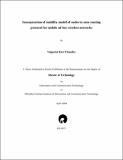Incorporation of mobility model of nodes in zone routing protocol for mobile ad hoc wireless networks
Abstract
Ad Hoc wireless networks are characterized by dynamically changing network topology due to relative motion of the nodes. This leads to the exchange of large number of control packets between the nodes to maintain the network topology resulting in reduced throughput in such networks and wastage of bandwidth in the exchange overhead control packets.
In this thesis, we propose the use of mobility models of the nodes to improve routing protocol performances. The basic idea is that the neighboring nodes exchange their mobility models (i.e., location and velocity information) during network updates and use this information to determine more stable routes that do not become invalid due to the nodes movement. This technique has been incorporated into one of the popular routing protocol for Mobile Ad Hoc Networks known as the 'Zone Routing Protocol'.
Among envisaged improvements with the above technique is determination of stable routes leading to reduction in the number of route failures, reduction in the number of overhead control packets, Scope for the use of directional antennas, bandwidth efficiency and reduction in power consumption at mobile nodes.
Simulations have been performed in MATLAB to analyse the performance of the ZRP with mobility models incorporated and the analysis results show decent improvements.
Collections
- M Tech Dissertations [923]

